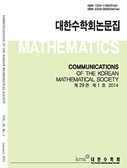Communications of the
Korean Mathematical Society
CKMS
Most Read
 VIEW ARTICLES
VIEW ARTICLES
 Most Read
Most Read
-
2023-07-31
Results concerning semi-symmetric metric $F$-connections on the Hsu-$B$ manifolds
Uday Chand De, Aydin Gezer, Cagri KaramanAbstract : In this paper, we firstly construct a Hsu-$B$ manifold and give some basic results related to it. Then, we address a semi-symmetric metric $F$-connection on the Hsu-$B$ manifold and obtain the curvature tensor fields of such connection, and study properties of its curvature tensor and torsion tensor fields.
-
2023-04-30
Singular and Marcinkiewicz integral operators on product domains
Badriya Al-Azri, Ahmad Al-SalmanAbstract : In this paper, we prove $L^{p}$ estimates of a class of singular integral operators on product domains along surfaces defined by mappings that are more general than polynomials and convex functions. We assume that the kernels are in $L(\log L)^{2}(\mathbb{S}^{n-1}\times \mathbb{S}^{m-1})$. Furthermore, we\ prove $L^{p}$ estimates of the related class of Marcinkiewicz integral operators. Our results extend as well as improve previously known results.
-
2022-10-31
Ground state sign-changing solutions for nonlinear Schr\"{o}dinger-Poisson system with indefinite potentials
Shubin Yu, Ziheng ZhangAbstract : This paper is concerned with the following Schr\"{o}dinger-\linebreak Poisson system$$\left\{\begin{array}{ll} -{\Delta}u+V(x)u+K(x){\phi}u=a(x)|u|^{p-2}u &\mbox{in}\ \mathbb{R}^3, \\[0.1cm] -{\Delta}{\phi}=K(x)u^{2}&\mbox{in}\ \mathbb{R}^3, \\[0.1cm]\end{array}\right.$$where $4<p<6$. For the case that $K$ is nonnegative, $V$ and $a$ are indefinite, we prove the above problem possesses one ground state sign-changing solutionwith exactly two nodal domains by constraint variational method and quantitative deformation lemma. Moreover, we show that the energy of sign-changing solutions islarger than that of the ground state solutions. The novelty of this paper is that the potential $a$ is indefinite and allowed to vanish at infinity. In this sense, we complementthe existing results obtained by Batista and Furtado \cite{BF18}.
-
2023-10-31
Space of homeomorphisms under regular topology
Mir Aaliya, Sanjay MishraAbstract : In this paper, we attempt to study several topological properties for the function space ${H(X)}$, space of self-homeomorphisms on a metric space endowed with the regular topology. We investigate its metrizability and countability and prove their coincidence at $X$ compact. Furthermore, we prove that the space ${H(X)}$ endowed with the regular topology is a topological group when $X$ is a metric, almost $P$-space. Moreover, we prove that the homeomorphism spaces of increasing and decreasing functions on $\mathbb R$ under regular topology are open subspaces of $H(\mathbb R)$ and are homeomorphic.
-
2023-01-31
Existence theorems for critical degenerate equations involving the Grushin operators
Huong Thi Thu Nguyen, Tri Minh NguyenAbstract : In this paper we prove the existence of nontrivial weak solutions to the boundary value problem \begin{align*} - G_1 u & =u^3 + f(x,y,u) \quad \text{ in } \Omega ,\\ u &\geq 0 \quad \text{ in } \Omega ,\\ u & =0 \quad \text{ on } \partial\Omega , \end{align*} where $\Omega $ is a bounded domain with smooth boundary in $\mathbb{R}^3$, $G_1 $ is a Grushin type operator, and $f(x,y,u)$ is a lower order perturbation of $u^3$ with $f(x,y,0)=0$. The nonlinearity involved is of critical exponent, which differs from the existing results in \cite{Tri:2018,TriLuyen:2020}.
-
2023-07-31
$\star$-conformal Ricci solitons on almost coK\"{a}hler manifolds
Tarak Mandal, Avijit SarkarAbstract : The main intention of the current paper is to characterize certain properties of $\star$-conformal Ricci solitons on non-coK\"ahler $(\kappa,\mu)$-almost coK\"{a}hler manifolds. At first, we find that there does not exist $\star$-conformal Ricci soliton if the potential vector field is the Reeb vector field $\theta$. We also prove that the non-coK\"ahler $(\kappa,\mu)$-almost coK\"ahler manifolds admit $\star$-conformal Ricci solitons if the potential vector field is the infinitesimal contact transformation. It is also studied that there does not exist $\star$-conformal gradient Ricci solitons on the said manifolds. An example has been constructed to verify the obtained results.
-
2023-04-30
Associated curves of charged particle moving with the effect of magnetic field
Muhammed Talat Sariaydin, Aziz YazlaAbstract : Magnetic curves are the trajectories of charged particals \linebreak which are influenced by magnetic fields and they satisfy the Lorentz equation. It is important to find relationships between magnetic curves and other special curves. This paper is a study of magnetic curves and this kind of relationships. We give the relationship between $\beta $-magnetic curves and Mannheim, Bertrand, involute-evolute curves and we give some geometric properties about them. Then, we study this subject for $\gamma $-magnetic curves. Finally, we give an evaluation of what we did.
-
2023-04-30
Generalized hyperbolic geometric flow
Shahroud Azami, Ghodratallah Fasihi~Ramandi, Vahid PirhadiAbstract : In the present paper, we consider a kind of generalized hyperbolic geometric flow which has a gradient form. Firstly, we establish the existence and uniqueness for the solution of this flow on an $n$-dimensional closed Riemannian manifold. Then, we give the evolution of some geometric structures of the manifold along this flow.
-
2023-04-30
Uniform distributions on curves and quantization
Joseph Rosenblatt, Mrinal Kanti RoychowdhuryAbstract : The basic goal of quantization for probability distribution is to reduce the number of values, which is typically uncountable, describing a probability distribution to some finite set and thus to make an approximation of a continuous probability distribution by a discrete distribution. It has broad application in signal processing and data compression. In this paper, first we define the uniform distributions on different curves such as a line segment, a circle, and the boundary of an equilateral triangle. Then, we give the exact formulas to determine the optimal sets of $n$-means and the $n$th quantization errors for different values of $n$ with respect to the uniform distributions defined on the curves. In each case, we further calculate the quantization dimension and show that it is equal to the dimension of the object; and the quantization coefficient exists as a finite positive number. This supports the well-known result of Bucklew and Wise \cite{BW}, which says that for a Borel probability measure $P$ with non-vanishing absolutely continuous part the quantization coefficient exists as a finite positive number.
-
2023-10-31
On graded $N$-irreducible ideals of commutative graded rings
Anass Assarrar, Najib MahdouAbstract : Let $R$ be a commutative graded ring with nonzero identity and $n$ a positive integer. Our principal aim in this paper is to introduce and study the notions of graded $n$-irreducible and strongly graded $n$-irreducible ideals which are generalizations of $n$-irreducible and strongly $n$-irreducible ideals to the context of graded rings, respectively. A proper graded ideal $I$ of $R$ is called graded $n$-irreducible (respectively, strongly graded $n$-irreducible) if for each graded ideals $I_{1}, \ldots,I_{n+1}$ of $R$, $I=I_{1} \cap \cdots \cap I_{n+1}$ (respectively, $I_{1} \cap \cdots \cap I_{n+1} \subseteq I$ ) implies that there are $n$ of the $I_{i}$ 's whose intersection is $I$ (respectively, whose intersection is in $I$). In order to give a graded study to this notions, we give the graded version of several other results, some of them are well known. Finally, as a special result, we give an example of a graded $n$-irreducible ideal which is not an $n$-irreducible ideal and an example of a graded ideal which is graded $n$-irreducible, but not graded $(n-1)$-irreducible.

Most Read
-
Study of gradient solitons in three dimensional Riemannian manifolds
Gour Gopal Biswas, Uday Chand De
Commun. Korean Math. Soc. 2022; 37(3): 825-837
https://doi.org/10.4134/CKMS.c210046 -
Equality in degrees of compactness: Schauder's theorem and $s$-numbers
Asuman Guven Aksoy, Daniel Akech Thiong
Commun. Korean Math. Soc. 2023; 38(4): 1127-1139
https://doi.org/10.4134/CKMS.c230003 -
Infinitely many homoclinic solutions for damped vibration systems with locally defined potentials
Wafa Selmi, Mohsen Timoumi
Commun. Korean Math. Soc. 2022; 37(3): 693-703
https://doi.org/10.4134/CKMS.c210008 -
A characterization of finite factorization positive monoids
Harold Polo
Commun. Korean Math. Soc. 2022; 37(3): 669-679
https://doi.org/10.4134/CKMS.c210270
Most Downloaded
-
S-coherent property in trivial extension and in amalgamated duplication
MOHAMED CHHITI, SALAH EDDINE MAHDOU
Commun. Korean Math. Soc. 2023; 38(3): 705-714
https://doi.org/10.4134/CKMS.c220260 -
The $p$-part of divisor class numbers for cyclotomic function fields
Daisuke Shiomi
Commun. Korean Math. Soc. 2023; 38(3): 715-723
https://doi.org/10.4134/CKMS.c220271 -
The dimension of the maximal spectrum of some ring extensions
Rachida EL KHALFAOUI, Najib Mahdou
Commun. Korean Math. Soc. 2023; 38(4): 983-992
https://doi.org/10.4134/CKMS.c220332 -
Existence and nonexistence of solutions for a class of Hamiltonian strongly degenerate elliptic system
Nguyen Viet Tuan
Commun. Korean Math. Soc. 2023; 38(3): 741-754
https://doi.org/10.4134/CKMS.c220080
Editorial Office
CKMS
© 2022. The Korean Mathematical Society. Powered by INFOrang Co., Ltd






